Thomas Frank is an artist/activist who creates complex multi-layered paintings that combine research regarding the impact of industrialization on our environment with an alluring and astute formal technique. Earlier this month, The COMP Magazine caught up with Frank to discuss his enduring connection with the Chicagoland region, the influence urban planning has upon his aesthetic practice, the heightened tactile sensuality found in encaustic painting, and how his ongoing environmental activism intersects with his present artistic investigations.
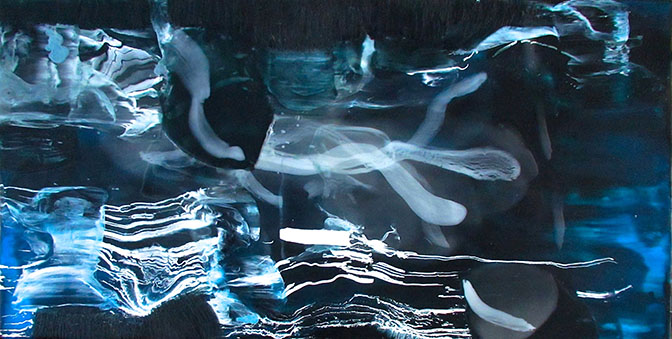
Thomas Frank, “An Evidence-Based-Approach Series II – 0001, ” Encaustic on panel, 10″ x 20″, Spring 2013
You and your family have a long history with Chicago. I believe your mother’s great-great-grandfather was Mayor of Chicago during the Great Chicago Fire of 1871. Is this correct? Can we start with an introduction to your connection to the Chicagoland area? Are there any specific items from your past that inform your current aesthetic practice?
This is tough. I still have a lot to unpack and internalize from both sides of my family. There has always been a measure of tension between them. My father grew up in Chicago’s Bucktown neighborhood in a German/Slovenian working class family, while my mom came from the affluent North Shore of English/Irish ancestry. My mom shared lots of fragments of memories from her childhood and pieces of information about our ancestry; especially stories about Roswell B. Mason being Mayor of Chicago during the Chicago Fire, the Kerfoots, General Sheridan, and other antidotes. It wasn’t until I studied Urban Planning that I began to form a wider picture of Roswell’s life as a civil engineer and what that might have meant for Chicago’s built environment.
I’m surprised by how my instinct to address problems in my immediate environment brought me to a similar conceptual approach that Roswell took, and that I was looking to solve some of the problems he had a hand in creating when forming Chicago’s early infrastructure. He translated the funds of early industrial capitalists into the built infrastructure for western expansion and the built environment of Chicago. He worked on the Erie Canal, designed the first bridge over the Mississippi, was the chief engineer on the Illinois Central Railroad to Chicago, and led the efforts to reverse the Chicago River. Using his established connections he became Mayor of a then scrappy, speculative and at the time the fastest growing city – Chicago. And then the city burnt down… The result of the fire cleared-out what has become known in large scale engineering projects as “overburden” to make room for a new round of large speculators, a new architecture, and later a master plan on the scale of Haussmann’s Paris. The commercial club was now in full control of the environment.
In inheritance, my Chicago is a century and half older and is now a mega-metropolis funded mostly by a technical information economy. My community is a heavily impacted low-income industrial community of color in Chicago’s Calumet industrial corridor on the southern shores of Lake Michigan. We are looking at redevelopment and revitalization scenarios that benefit the people who live here. By living here, I’ve been exposed to the social inequities in our region.
My work as an Artist/Activist has a lot to do with the impacts of rapid industrialization and capital abandonment found in communities like mine. My art grapples with my process of internalizing some of the abstract and displaced visual frameworks I see loaded with meaning and governing these existing conditions.
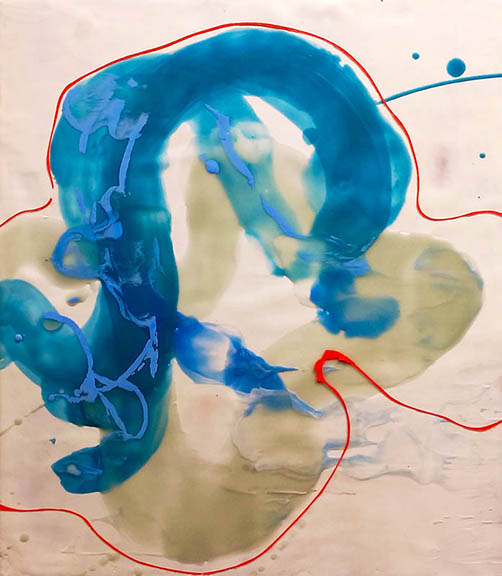
Thomas Frank, “Empirical Frame – 0002” 12″ x 14”, Encaustic on panel, 2015
Can we discuss the series “Under the Plume of Permitting”, 2012? These translucently layered encaustic paintings remind me of organic forms one might encounter in nature or in a field sample one may view through a microscope. Simply put, I see the amorphous forms as non-static, sinuous and rather active. Can you share with us an overview of your application and intent?
“Under the Plume of Permitting” is part of a larger series called the “The Lake Effect Series.” I see the paintings as portraits of our environmental regime, through metaphors of plumes. They resolve themselves in a contemplative ambient space with simple references to representations, spectrums of intensities, and data visualization techniques. For me the plumes are like samples identifying existing conditions, causal agents and location.
I like to use encaustic because it is a medium that strongly asserts its physical qualities. It can be easily made from raw materials, and has a significant mass that can be somewhat translucent. When you heat the wax and introduce pigment, it naturally creates plumes. In building layers, I can put the pigments through different applications and stresses. In some cases the plumes of pigment diffuses, in other cases it fragments, scatters or breaks apart. They can resemble characteristics of bone formations, tissues, cellular structures, liquid, gases and land masses. The paintings are layers of visual information of differing frameworks with subtle shifts in orientation.
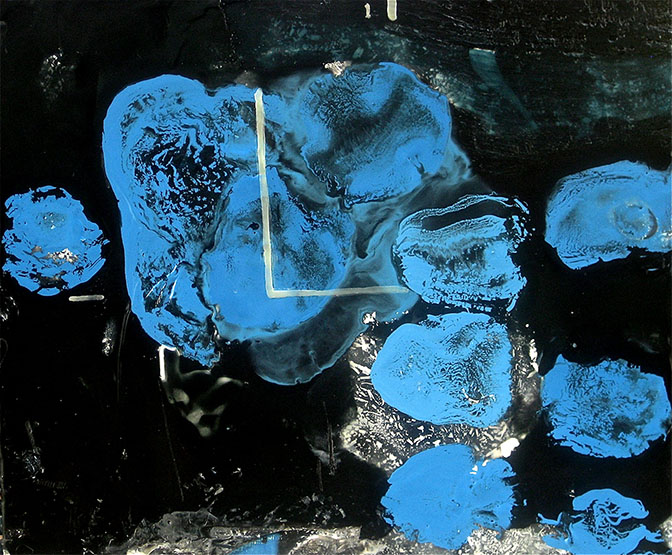
Thomas Frank, “Under the Plume of Permitting – 08”, 12” x 14”, Encaustic on panel, 2012
What do you value in the process of painting?
Seduction. I love the hands on physical intimacy of the medium and the surfaces that can be created. I like responding to it and to what I see and feel. The place I come to always suggests an alternative path. When that happens, I usually take up a new series to explore further. Sometimes they lead in a clear direction but more often it brings me to a new sort of space that disorientates me, so I tend to stop and set the piece aside till I either need to go back into it or I gain an orientation by shifting my way of seeing it. Art gives me the opportunity to explore and ruminate with issues of identity and space.
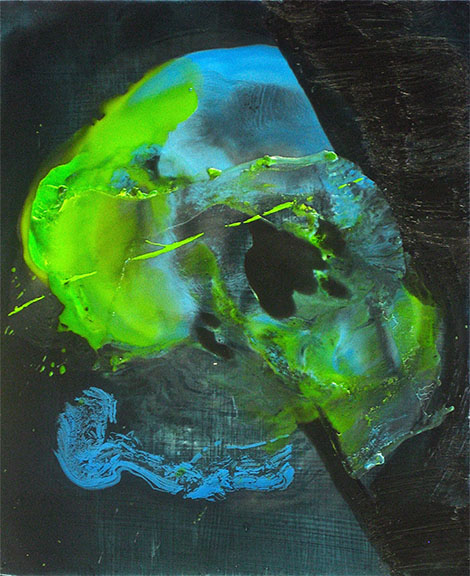
Thomas Frank, “Under the Plume of Permitting – 15”, 10” x 12”, Encaustic, on panel 2012
Over the years, you’ve voiced the importance of being a good steward for the earth. Your passion for making the public and government entities aware of flagrant industrial abuse and oversight to our environment appears to relate to your ongoing investigations as an artist. Do you see an overlap or connection between the paintings you produce and your environmental activism?
Well, as an Urban Planner I was the Executive Director of the Indiana Harbor Shipping Canal (IHSC) located on the southern shores of Lake Michigan. At the time the IHSC was considered the most polluted body of water in North America. That experience informed a lot of the work I do today, not just as an environmental activist, but also as an artist.
By doing this work I’ve become more aware of how our political economy allocates resources, cultural narratives and privileges certain voices over others. Although we all live on the same planet, we certainly don’t breathe the same air, or drink the same water, or use the same land. Some environments are more equal than others. This is a fight for environmental justice.
I now see myself as an artist/activist. However, my art is much more physically intimate and grapples with a larger, longer and abstract framework, while my activism is much more socially present and addresses more practical power dynamics. They do inform each other, but I don’t feel the need to resolve one into the other. I don’t intend my art to do what my activism does, and I don’t intend my activism to do what my art does.
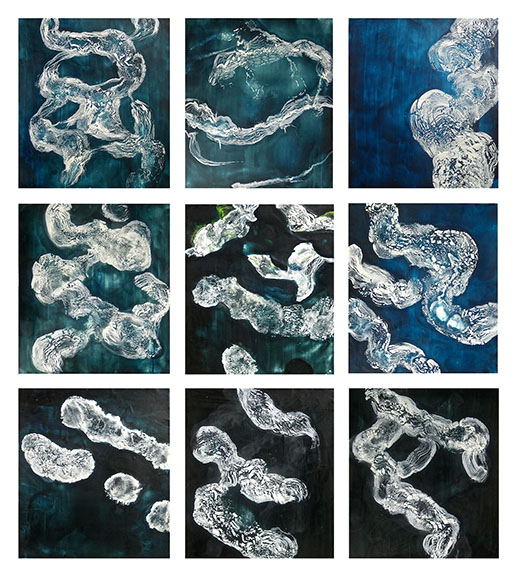
Thomas Frank, “Water Column Series II – 9”, 65” x 76”, Encaustic on panel, 2010
A number of years ago (1995, I believe?), I remember looking at your work at your Spice Factory studio in Chinatown and noting that your paintings hold an affinity with the work of the painter Terry Winters. Does Winters or any other painter’s investigations pique your interest? What are you looking at currently?
That was an exciting time. Like most MFA graduates, I struggled to get out of graduated school and the Spice Factory was a place for me to undress my work and think about a career in the arts. However, not entirely surprising, I was very resistant to the art market and galleries, so I just didn’t approach them. I looked for other ways to support, inform and show my art. That’s how I got involved in medical education and urban planning. At the Spice Factory I was doing mostly large scaled pieces on moving pads I got from my day job moving furniture. For the first time I was using wax with tar, oils and an aggregate. The paintings felt like very large slow explosions. They were influenced by Terry Winters, Leon Golub, Mark Lombardi and data graphics, but also my fellow graduates like Paul Pollaro and Michelle Oosterbaan.
Today, I look at an array of artists and resources including those I already mentioned but also: Bridget Riley, Jacqueline Humphries, Yfat Gat, Hans Haacke and many, many others. I continue to look at a lot of planning documents, medical imagining, fMRIs, data visualization, and mapping techniques.
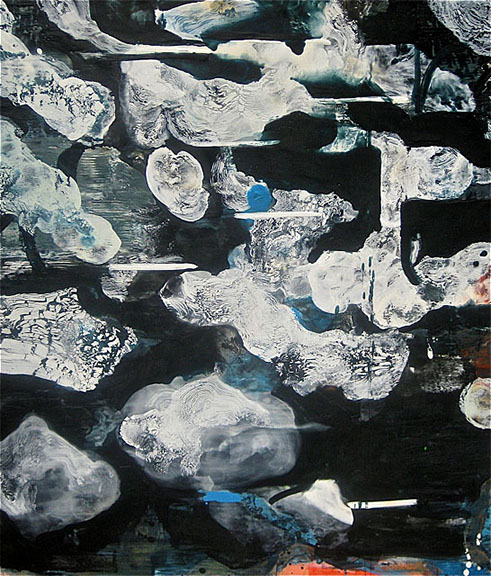
Thomas Frank, “Water Column Series II – 003”, 41” x 47”, Encaustic on panel, 2010
What are your plans for 2016? What are you currently working upon in the studio?
Currently, I’m working on two bodies of work that came out of an earlier series called “An Evidence-Based Approach.” I’m still discovering where they are heading.
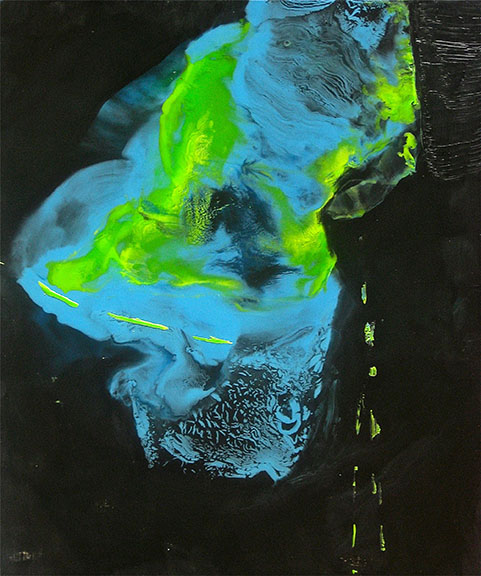
Thomas Frank, “Under the Plume of Permitting – 01”, 12” x 14”, Encaustic on panel, 2012
For additional information on the work of Thomas Frank, please visit:
Thomas Frank – www.thomasfrank.org
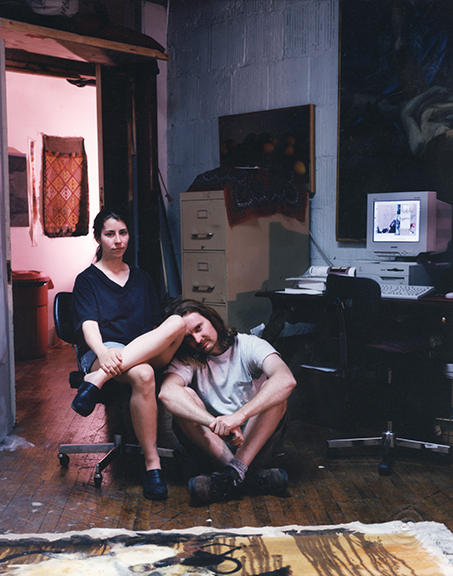
Kristin Todd and Thomas Frank, Chicago, IL, 1995
Artist interview and portrait by Chester Alamo-Costello


